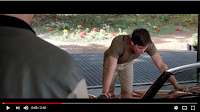Post 35- Film History- The Silent Era
Educated at La Martiniere, Lyon’s largest technical high school, the Lumière brothers went on to work for their father, Antoine Lumière (1840–1911), an artist turned businessman who specialised in the manufacturing and selling of photographic equipment.
Thomas Edison’s peephole Kinetoscope invention in 1891 invited new possibilities in the photographic industry. Akin to the simulated running men we create by flicking through the pages of post-it note pads, the Kinetoscope created the effect of a motion picture, as sequential images on film were played on loop over a light source with a high-speed shutter. Its drawbacks though, were its impracticality as an immense piece of machinery through which only one individual could view the film at a time.Auguste and Louis Lumiere are credited with the world's first public film screening on December 28, 1895. The showing of approximately ten sHowever, stirred by this new direction and heartened by their own innovations, the Lumière brothers (above) sought to overcome the Kinetoscope’s restrictions. By 1895, they had innovated the portable and much lighter Cinématographe: a trinity of camera, printer and projector.
Likened to that of a sewing machine, the Cinématographe thread film intermittently and at a comparatively slower speed than the Kinetoscope. This had the simultaneous effect of reducing the clamour caused by rotating film and improving the appearance of fluid movement. Perhaps most importantly, though, it meant that whole audiences could see the projecting images. The Lumière’s Cinématographe not only created the filmmaker, it created the viewer.
Louis seized the world around him through his camera and the first private screening of their motion pictures was held on December 28, 1895 at the Salon Indien du Grand Café in Paris. This landmark event was a presentation of 10 short films of approximately 50 seconds each. Their directorial debut was ‘La sortie des usines Lumière’ (‘Workers leaving the Lumière Factory’). While the title did not leave much to the imagination, (the plot and storyline was just that), their invention did, forever changing the way we imagine our world and view our imaginations. These brief films were the arrival of a new dawn in the arts: the cinema.
The brothers opened theatres to screen their films and eventually collated a catalogue of thousands of titles. Despite their success and radical technological foresight, the Lumière brothers did make one miscalculated forecast, curiously quoted as having said, “The cinema is an invention without any future.”hort films lasting only twenty minutes in total was held in the basement lounge of the Grand Cafe on the Boulevard des Capucines in Paris and would be the very first public demonstration of their device they called the Cinematograph which effectively functioned as camera, projector and printer all in one.
Le cinematographe - 1985 (front and side views)
Their work consisted mainly of moving images from scenes of everyday life. Ironically as we look back in retrospect in comparison to what film has developed into today, the Lumiere Brothers believed it to be a medium without a future as they suspected that people would bore of images that they could just as easily see by walking out into the street. However, their film sequence of a train pulling into the station reportedly had audiences screaming and ducking for cover as they believed that the train itself was about to plow into the theater.




Comments
Post a Comment